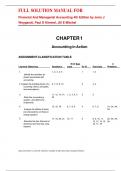Exam (elaborations)
Solution Manual for Accounting Principles Volume 1 & Volume 2, 9th Canadian Edition Jerry J. Weygandt, Verified Chapters 1 - 20, Complete Newest Version
Solution Manual for Accounting Principles Volume 1 & Volume 2, 9th Canadian Edition Jerry J. Weygandt, Verified Chapters 1 - 20, Complete Newest Version Solution Manual for Accounting Principles Volume 1 & Volume 2, 9th Canadian Edition Jerry J. Weygandt, Verified Chapters 1 - 20, Complete Newest V...
[Show more]



